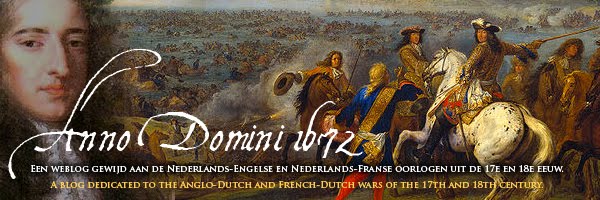
Het duurde tot het jaar 1937 dat de kleuren van de nederlandse vlag werden vastgesteld in rood-wit-blauw. Hieraan gingen middels boeken, pamfletten en krantenartikelen een polemiek vooraf, of de kleuren nu rood-wit-blauw of oranje-wit-blauw moesten worden, en op de leestafel heb ik bijvoorbeeld 'De Nederlandsche Vlag' van C. de Waard, uit 1900 en 'Wat is de oorsprong van onze vlag', van Ir L. Jonker Czn, uit 1937, en 'De legervlaggen uit den Aanvang van den Tachtigjarige oorlog' uit 1938.
Interessant uit het boek van de Waard:
76. Den 22 Februari 1666 gaf de Raad van State bevel tot het maken van 100 veldvaandels en 48 kornetvaandels van de volgende kleuren.
Vaandels: rood; wit; geel; groen en geel; blauw; oranje; wit-zwart en rood; wit en zwart; wit en groen; en rood en wit; Van elk 10 standaards: rood met een wit kruis; blauw; oranje; geel; wit; zwart en wit; rood en wit; rood van elk 6.
Helaas ontbreekt een nadere beschrijving. Enig idee?
~~
The colours of the dutch national flag were established in the year 1937. It took decades (some would say centuries) before a final decision was made between the orange-white-blue and red-white-blue and some great books were written on the subject to prove one's point. In the dutch text I gave some titles, and from the book of C. de Waard I take a quote on the colours of the land army:
76. On the 22th of February the Raad van State ordered that 100 fireld colours should be made and 48 cavalry banners, in the following colours: red, white, yellow, green and yellow, blue, orange, white black and red, white and black, white and green, red and white. For the cavalry: red, whith a white cross, blue, orange, yellow, white, black and white, red and white, red.
Unfortunatly details are not available. Any ideas?




Mmm, interessant. ik kan me voorstellen dat de genoemde kleuren basiskleuren voor de vaandels zijn, met daarop wisselende motieven. Qua rekensom kom ik correct uit op 100 infanterievaandels (10 vaandels van 10 kleuren(combinaties) elk, en kornetvaandels dito: 6 vaandels per 8 kleuren = 48. Kruizen klinken erg katholiek...
BeantwoordenVerwijderenMats,
BeantwoordenVerwijderenThe white cross might be a St. Andrew cross or "X" similar to those on the Arms of Amsterdam.
Dan
The St-Andrew's cross was linked to the Spanish, so I don't think that's an option. Though the town of Amsterdam was very powerful, I don't think it had THAT much influence..
BeantwoordenVerwijderenedwin
Mats,
BeantwoordenVerwijderenI do not believe one can rule out anything, because we just do not know! What is your explanation for the "cross"?
Dan
"Deze prent leert nog meer, namelijk dat de opstandige Nederlanders na de verlating van Philips II op 14 juli 1581 het Bourgondisch Kruis hebben afgeschaft."
BeantwoordenVerwijderenUit: Mr.J.P.W.A. Smit, De legervlaggen uit den aanvang van den 80-jarigen oorlog, Van Gorcum, Assen 1938, p. 39.
A square cross, or St.George's cross, shows French influence, and in 1666 the French were still not enemies.
Mats,
BeantwoordenVerwijderenThanks for the tip on the Smit's book. 72 pages covering 350 years, does it have anything specific on the 1660s and 1670s? I have located a copy, but want to make certain that it contains information on the period in which I am interested.
My interpertation of the Cross of Burgundy is obviously different from yours. I see no problem with a white "X" and not the ragged, red Cross of Burgundy. Your initial comment seemed to raise a question because a white cross was "Catholic". Now you are saying it is all right because France was not an enemy of the United Provinces in the early 1660s. I doubt flags were changed just because a cross was similar to Spanish or French, depending on who the ally was. Does this mean that in the 1670s the Cross of Burgundy was OK because Spain was now an ally?
Dan
Dan,
BeantwoordenVerwijderenThe Smit book deals with the 80 years war, especially with the 16th century. Smit was head of the Archive of the Province of Brabant, and his notes are quite extensive and go beyond the 80 years war (so ending in 1648, and no info on the 1670's). And yes, flags were actually changed because it had a St Andrew's cross in it!
Mats relates a cross to catholicism. The States' Army had square crosses for a short time that could be linked to the duke of Anjou, a 'sovereign to be'. And was Spain an ally in the 1670's? I think it took them to 1674 to join William III.
edwin